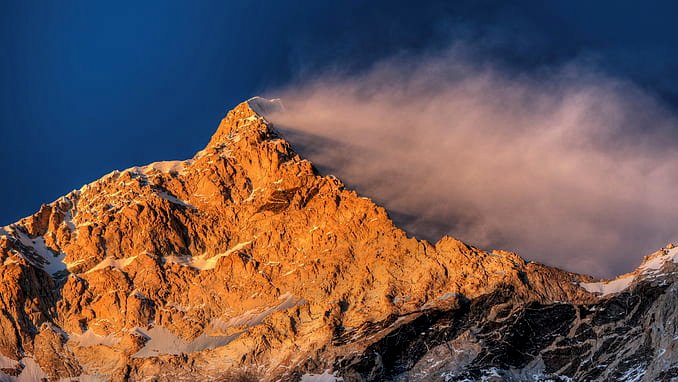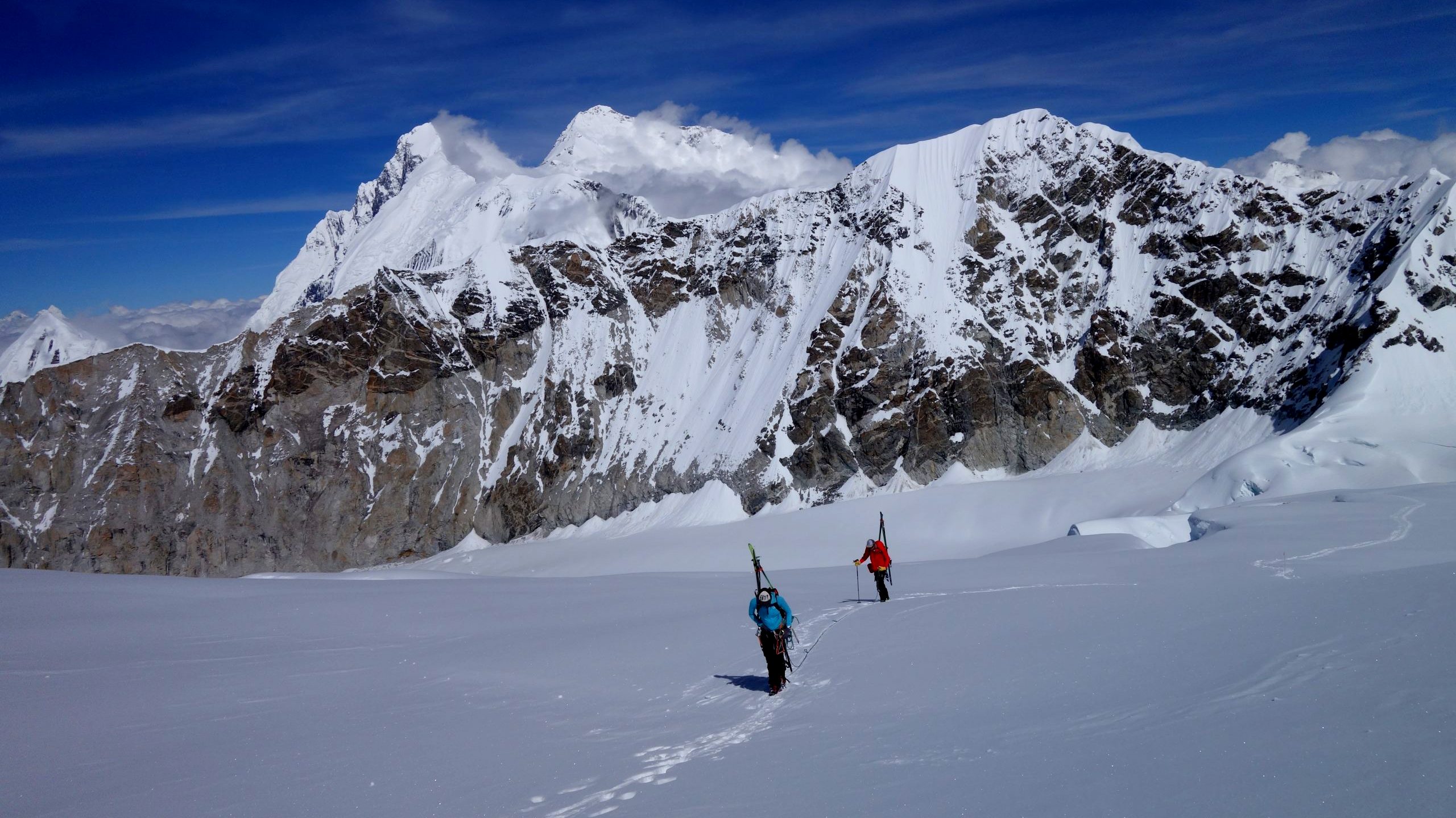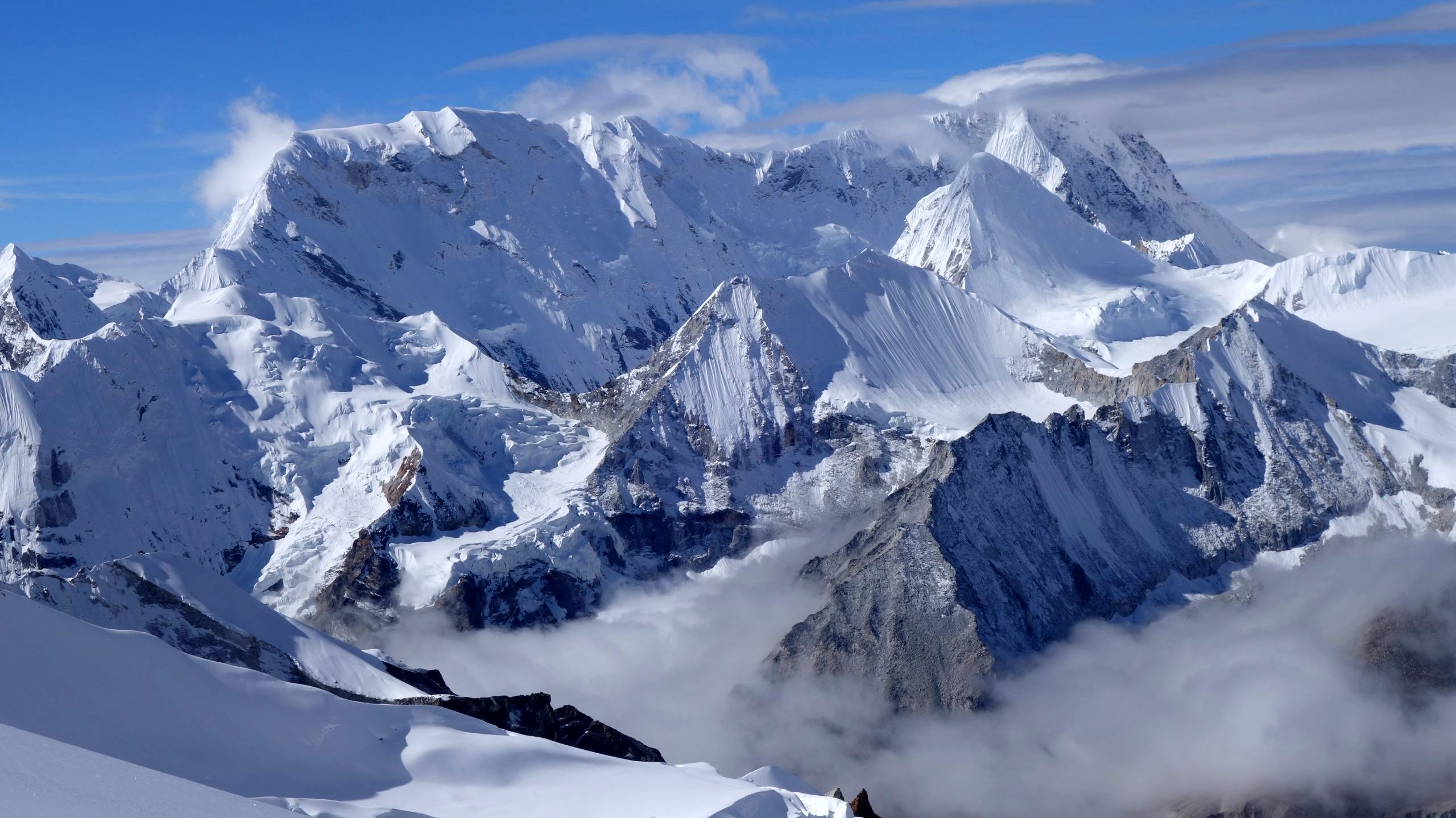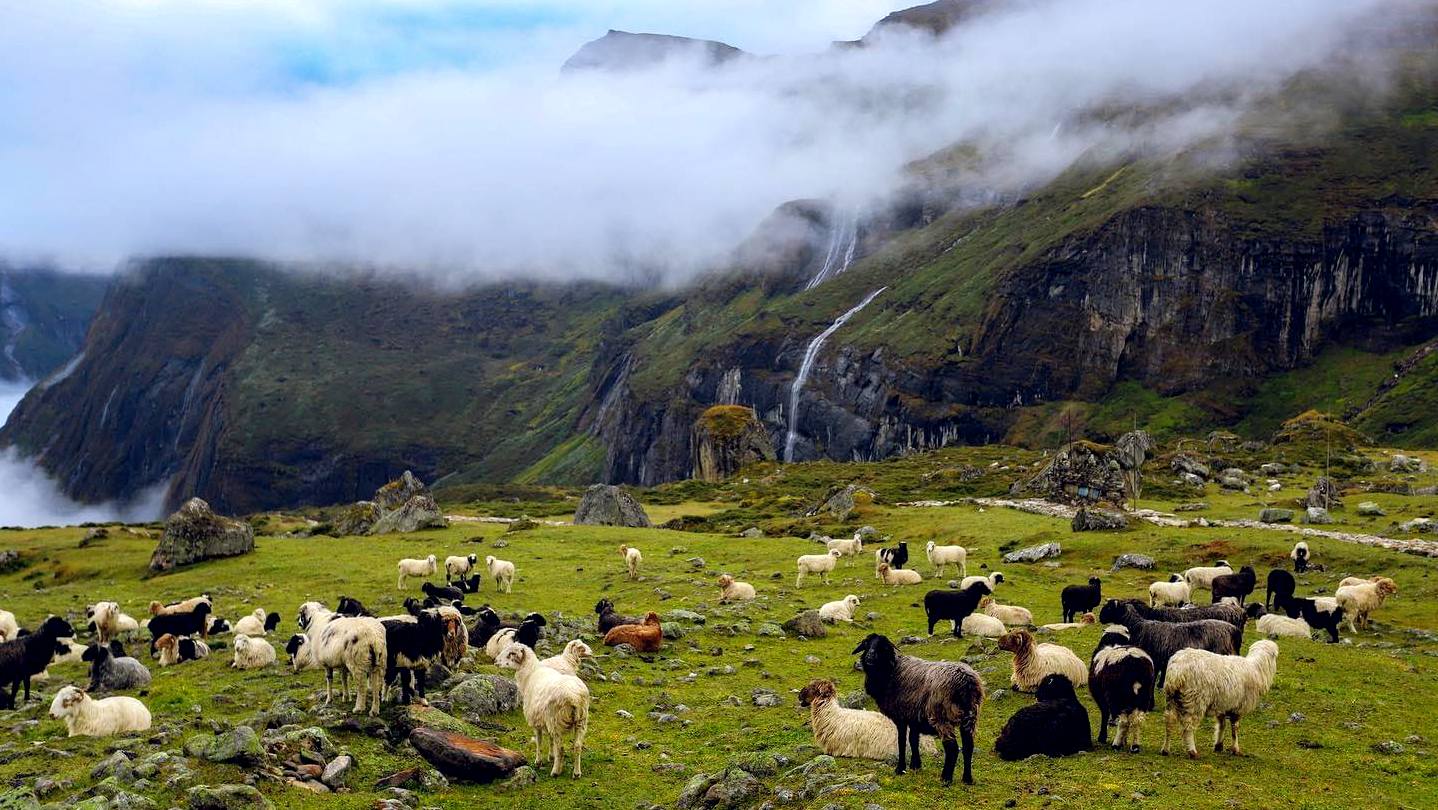Makalu Expedition
Mount Makalu is the fifth-highest mountain in the world, with an elevation of 8,463 meters (27,766 feet). It has a distinctive four-sided pyramid shape and is known for its rugged terrain. It is located in the Mahalangur Himal range of the Himalayas, on the border between Nepal and China. Makalu is a challenging climb and is considered to be one of the most difficult eight-thousanders to ascend. The mountain is known for its steep slopes, exposed ridges, and unpredictable weather.
The expedition typically starts with a flight from Kathmandu to Tumlingtar, followed by a trek through the beautiful Arun River valley and Sherpa settlements. The chosen route leads to the base of the West Face at around 5,800 meters (19,029 feet). From there, climbers proceed toward the breathtaking Barun Valley, which is known for its natural beauty and diverse flora and fauna.

Establishing base camp at approximately 5,600 meters (18,373 feet), climbers then set up additional camps at higher altitudes to acclimatize and make their way toward the summit. The route may vary depending on the expedition's specific plans and the conditions on the mountain. Reaching the summit of Mount Makalu involves technical climbing, including rock sections and challenging terrain. Climbers need to have advanced mountaineering skills, physical fitness, and experience in high-altitude climbing to undertake this expedition.
History of the Makalu Expedition
The climbing history of the Makalu Expedition started in the 1950s and has witnessed notable achievements. In 1954 a New Zealand team led by Sir Edmund Hillary, who famously conquered Mount Everest in 1953, made the first recorded attempt on Makalu. However, they were unable to reach the summit due to challenging weather conditions. And in 1955 the French mountaineering team led by Jean Franco undertook an expedition to Makalu. On May 15, 1955, Lionel Terray and Jean Couzy successfully reached the summit via the mountain's north face and northeast ridge. This marked the first ascent of Makalu and was a significant accomplishment in mountaineering history.

Since then, numerous expeditions have taken place, with climbers from around the world attempting to conquer Makalu. Each expedition has brought its own challenges and achievements, contributing to the climbing history of the mountain. However, the elusive winter ascent of Makalu remains unconquered, making it the only Nepalese eight-thousanders that have yet to be climbed in true winter conditions. The climbing history of Makalu reflects the determination, skill, and perseverance of mountaineers who have dared to take on its formidable slopes. It stands as a testament to human endurance and the spirit of exploration.
Highlights of the Makalu Expedition
- The majestic mountain beauty of Mount Makalu, with its distinctive pyramid shape and knife-edged ridges.
- Challenging technical climbing attracts experienced climbers seeking a demanding and exhilarating expedition.
- Spectacular Himalayan panorama, offering breathtaking views of neighboring peaks like Everest, Lhotse, Kanchenjunga, and Cho Oyu.
- Remote and untouched wilderness, traversing rugged landscapes, deep valleys, high passes, and dense forests.
- Cultural encounters with local Sherpa and ethnic communities, providing insight into their traditions and way of life.
- Personal achievement of conquering the summit, represents physical and mental preparation, perseverance, and a sense of pride.
- An immersive experience in the grandeur of the Himalayas, surrounded by stunning landscapes and a profound sense of accomplishment.
Routes for the Makalu Expedition
There are two main routes that are used for climbing Mount Makalu: the Southeast Ridge and the Northwest Ridge.
Southeast Ridge Route
The Southeast Ridge is the most popular route for climbing Makalu. It is a relatively straightforward route that is not as technical as the Northwest Ridge. However, it is still a challenging climb and should only be attempted by experienced climbers.
Makalu Base Camp (4,800 meters): This is the starting point for the expedition. It serves as the initial acclimatization and preparation area.
Camp 1 (5,700 meters): Located along the Southeast Ridge, climbers establish this camp to further acclimatize and rest before proceeding to higher altitudes.
Camp 2 (6,400 meters): Situated higher on the Southeast Ridge, this camp is strategically positioned for climbers to continue their ascent. From here, climbers can enjoy panoramic views and prepare for the more challenging sections.
Camp 3 (7,200 meters): Positioned on a col between Makalu and Chomo Lonzo, this camp marks a significant point in the climb. Climbers often spend time here for additional acclimatization and to prepare for the final push to the summit.
Summit Push: The summit push begins from Camp 3, usually in the early hours of the morning, and takes approximately 12 hours to reach the summit. Climbers must navigate challenging terrain, including technical sections and steep slopes, to reach the summit of Mount Makalu.

Northwest Ridge Route
The Northwest Ridge is the more technical route for climbing Makalu. It is a steeper and more difficult climb than the Southeast Ridge. And it offers better views of the mountain and the surrounding area.
Makalu Base Camp (4,800 meters): Same as on the Southeast Ridge route, the climbers start their journey from Makalu Base Camp for acclimatization and preparations.
Camp 1 (5,700 meters): Positioned along the route on the Northwest Ridge, this camp serves as an intermediate resting and acclimatization point.
Camp 2 (6,400 meters): Located higher on the Northwest Ridge, this camp provides climbers with a strategic vantage point to continue their ascent. It offers better views of the mountain and the surrounding area.
Camp 3 (7,200 meters): Positioned on a col between Makalu and Chomo Lonzo, this camp serves as a high-altitude camp for further acclimatization and final preparations for the summit push.
Summit Push: The summit push from Camp 3 follows a similar timeline and challenges as on the Southeast Ridge route. Climbers face steep and technical sections as they ascend toward the summit, requiring advanced mountaineering skills and experience.
It's important to note that the specific locations and altitudes of the camps can vary depending on the expedition and the route conditions.
Mountain views are seen during the Makalu Expedition
Makalu Expedition offers an incredible climbing experience with the opportunity to witness the magical views of the majestic Himalayan ranges and surrounding peaks. The expedition presents a panoramic feast for the eyes, showcasing some of the world's highest and most iconic mountains such as Mount Makalu, Mount Everest, Lhotse, Kanchenjunga, Cho Oyu, Gyachung Kang, Chamlang, Ama Dablam, Baruntse, and many more.

How Difficult Is The Makalu Expedition?
The Makalu Expedition is renowned as one of the most difficult and challenging mountaineering expeditions in the world. It requires climbers to possess advanced mountaineering skills, extensive experience, and exceptional physical fitness. The technical difficulty of the climb is notable, with steep sections, knife-edged ridges, and technical rock climbing adding to the challenge. The altitude of Mount Makalu, standing at 8,463 meters (27,766 feet), presents a significant hurdle as climbers must contend with thin air, decreased oxygen levels, and the risk of altitude-related illnesses. The unpredictable and harsh weather conditions on the mountain, including strong winds, extremely cold temperatures, and snowstorms, further intensify the difficulty.
The remote location of Makalu adds logistical challenges, requiring climbers to navigate rugged terrain, and glaciers, and establish multiple high-altitude camps. The expedition's duration, typically lasting several weeks to months, demands mental and physical endurance, as climbers face living in tents, enduring extreme conditions, and managing limited resources. Due to these factors, the Makalu Expedition is reserved for highly experienced climbers who possess the necessary skills, conditioning, and training to tackle the immense challenges posed by this formidable peak.
How to prepare for the Makalu Expedition
Preparing for the Makalu Expedition requires thorough planning and physical, technical, and mental preparation. Focus on building your physical fitness through a comprehensive training regimen that includes cardiovascular exercises, strength training, and endurance activities. Acclimatization is crucial for high altitudes, so plan your expedition schedule with gradual ascents and incorporate rest days to allow your body to adapt. Develop advanced mountaineering skills, including ice climbing and technical gear handling. Invest in high-quality mountaineering equipment and ensure you are familiar with its use. Mentally prepare yourself for the challenges ahead, including adverse weather conditions and difficult decision-making. Gain prior expedition experience to understand the logistics and safety protocols involved. Foster effective teamwork and communication with your climbing partners. Maintain a nutritious diet and stay hydrated during the expedition. Prioritize safety and risk management, and be prepared to make decisions that prioritize your well-being. Obtain the necessary permits and consider hiring experienced guides or joining reputable expedition companies for guidance and support. With careful preparation, you can enhance your chances of a safe and successful Makalu Expedition.
Permits for the Makalu Expedition
Permits are required for the Makalu Expedition, and climbers must obtain the necessary permits before undertaking the expedition. Here are the permits typically required for the Makalu Expedition:
Makalu-Barun National Park Entry Permit: The Makalu-Barun National Park is a protected area through which the Makalu Expedition passes. Climbers need to obtain an entry permit for the national park. The permit can be obtained from the Department of National Parks and Wildlife Conservation in Kathmandu or at the entry point of the national park.
Makalu Restricted Area Permit: As Makalu is located in a restricted area, climbers must obtain a Makalu Restricted Area Permit. This permit is issued by the Department of Immigration in Kathmandu or by the Trekking Agency Association of Nepal (TAAN).
Climbing Permit: Climbers also need to obtain a climbing permit for Mount Makalu. This permit is issued by the Nepal Mountaineering Association (NMA).
Liaison Officer: As per regulations, a Liaison Officer is required to accompany the climbing team during the Makalu Expedition. The Liaison Officer serves as a liaison between the team and the authorities, ensuring compliance with regulations and providing assistance as needed.
Best Season For Makalu Expedition
The best seasons for the Makalu Expedition are spring (March to May) and autumn (September to November). These seasons offer the most favorable weather conditions and increased chances of a successful climb. Here are the explanation of each season and the weather conditions;
Spring (March to May)
Spring is considered the prime season for the Makalu Expedition. The weather during this period is generally stable and favorable for climbing. The temperatures begin to warm up, creating more comfortable conditions for climbers. The skies are often clear, providing excellent visibility and stunning views of the surrounding peaks and landscapes. The snow and ice conditions are relatively stable, making the climbing routes more accessible and safer. Spring also marks the end of the winter season, reducing the risk of avalanches. Overall, spring offers a great balance of favorable weather, stable climbing conditions, and beautiful scenery.
Base Camp: Daytime temperatures can range from around 0°C to 10°C (32°F to 50°F), while nighttime temperatures can drop to around -10°C to -20°C (14°F to -4°F).
Higher Camps: As you climb higher toward the summit, temperatures can drop significantly. During the day, temperatures may range from -10°C to -20°C (14°F to -4°F), and at night, they can plummet to -20°C to -30°C (-4°F to -22°F) or even lower.
Summer (June to August)
The summer season in the Makalu region corresponds to the monsoon season in Nepal. It is characterized by heavy rainfall, frequent storms, and cloudy conditions. The mountain experiences significant precipitation, which can make the climbing routes slippery, unstable, and dangerous. The increased risk of landslides and avalanches further adds to the challenges. Due to adverse weather conditions and safety concerns, the summer season is not recommended for the Makalu Expedition. It is generally a time when climbers avoid attempting the climb.
Base Camp: Daytime temperatures at the base camp can range from 5°C to 15°C (41°F to 59°F), with nighttime temperatures between -5°C to 5°C (23°F to 41°F).
Higher Camps: As you climb higher, temperatures at higher camps can vary from -5°C to -15°C (23°F to 5°F) during the day, and at night, they can drop to -15°C to -25°C (5°F to -13°F) or lower. It's worth noting that this period also experiences heavy rainfall and an increased risk of avalanches.

Autumn (September to November)
Autumn is another popular season for the Makalu Expedition. The weather during this time is generally stable, with clear skies and reduced chances of precipitation. The temperatures start to cool down after the monsoon season, creating pleasant and comfortable climbing conditions. The visibility is excellent, offering breathtaking views of the mountains and surrounding landscapes. The snow and ice conditions are relatively stable, allowing for safer and more efficient climbing. Autumn is considered a favorable season for climbers seeking a successful ascent of Mount Makalu.
Base Camp: Daytime temperatures can range from 0°C to 10°C (32°F to 50°F) at the base camp, with nighttime temperatures dropping to around -10°C to -20°C (14°F to -4°F).
Higher Camps: As you climb higher, temperatures during the day can range from -10°C to -20°C (14°F to -4°F), and at night, they can drop to -20°C to -30°C (-4°F to -22°F) or lower. Autumn is generally considered the best season for climbing Makalu due to more stable weather conditions.
Winter (December to February)
Winter is the coldest season in the Makalu region and brings extreme weather conditions. The temperatures drop significantly, reaching well below freezing at high altitudes. The mountain experiences heavy snowfall, and the climbing routes are covered in deep snow. The harsh winter conditions, including strong winds and freezing temperatures, make climbing extremely challenging and dangerous. Due to the severity of the weather and the increased risk of avalanches and frostbite, the winter season is not recommended for the Makalu Expedition. It is a time when only highly experienced and specialized climbers attempt the mountain under strict winter mountaineering conditions.
Base Camp: Daytime temperatures at the base camp can range from -5°C to 5°C (23°F to 41°F), with nighttime temperatures dropping to around -15°C to -25°C (5°F to -13°F) or lower.
Higher Camps: As you climb higher, temperatures during the day can vary from -10°C to -25°C (14°F to -13°F), and at night, they can drop to -25°C to -40°C (-13°F to -40°F) or even lower. Winter climbing on Makalu is extremely challenging due to severe cold and high winds.
Each season brings its own set of advantages and challenges for the Makalu Expedition. Spring and autumn are the preferred seasons due to their more favorable weather, stable climbing conditions, and increased chances of success. It's important for climbers to carefully plan and choose the appropriate season based on their experience, skills, and the specific challenges they are prepared to face.
Accommodation and Meals During The Makalu Expedition
During the Makalu Expedition, accommodation primarily consists of camping in tents. The Luxury Holiday Nepal Team will provide all the necessary camping equipment, including base camp tents, foam flooring, shower tents, and toilet tents. At the Makalu Base Camp, each person is allocated their own tent, while at the upper base camp, three people typically share one tent. The private camp will also have a cooking tent equipped with camping-friendly utensils.
Meals during the expedition are carefully prepared to provide both nourishment and enjoyment. Qualified Western chefs oversee the cooking process and ensure proper hygiene practices. The food is designed to cater to the climbers' needs and combat altitude-induced hunger. Each day, three hot meals are served, along with a variety of appetizers for gatherings at the base camp. The menu consists of a diverse and nutritious range of Western cuisine. Fresh ingredients and meats are sourced from the local market, supplemented by a selection of international meals and snacks.
The emphasis is placed on maintaining a high standard of quality and hygiene to support climbers' physical well-being throughout the journey. Special attention is given to acclimatization by including ingredients in the evening soup that aid in adjusting to the altitude. Overall, climbers can expect delicious meals and a satisfying dining experience during the Makalu Expedition.
Cost of Makalu Expedition
Makalu, the fifth-highest mountain in the world, located in the Himalayas, presents a challenging and exciting goal for experienced climbers. Here's a rough estimate of what the costs might look like:
- Expedition Fee: The price for a full-service expedition usually ranges from $30,000 - $60,000 per person. This typically includes services such as transportation, meals, accommodation in Kathmandu, base camp services, climbing Sherpas, and group gear like ropes, tents, and cooking equipment.
- Travel Costs: Depending on where you are traveling from, flight costs to Kathmandu, Nepal could range from $500 to $2,000.
- Climbing Permit: The climbing permit for Makalu issued by the Nepal Ministry of Tourism can range from $1,000 - $5,000 depending on the time of year, with the spring season (April-May) being the most expensive.
- Insurance: Comprehensive travel insurance that covers high altitude mountaineering can be a significant cost, potentially several hundred to over a thousand dollars, depending on your age, health, and the specific coverage details.
- Gear: Mountaineering requires specialized equipment. If you don't have it already, you might spend $2,000 - $5,000 for items like climbing boots, down suits, crampons, ice axes, harness, helmet, and other personal climbing gear.
- Training: Training for high-altitude mountaineering often involves taking climbing courses, which will also add to your costs.
- Miscellaneous Costs: These can include visas, tips for guides and porters, additional hotel stays, personal supplies, and emergency funds.
The actual cost can vary significantly depending on a variety of factors, including the outfitter you choose, the services they provide, the length of your expedition, your gear needs, and so on.
Checklist for the Makalu Expedition
Here is a checklist for the Makalu Expedition to ensure you have all the necessary items for a successful and safe climb:
Clothing
- Base layers (tops and bottoms)
- Insulated mid-layers (fleece or down jacket)
- Waterproof and windproof outer shell jacket and pants
- Insulated pants or mountaineering trousers
- Climbing gloves or mittens
- Thermal socks
- Mountaineering boots
- Gaiters
- Warm hat and balaclava
- Sunglasses with UV protection
- Sun hat or cap
- Neck gaiter or scarf
Climbing Equipment
- Mountaineering boots suitable for cold and high-altitude conditions
- Crampons
- Ice axe
- Climbing harness
- Climbing helmet
- Ascenders and descenders
- Carabiners and quickdraws
- Prusik cords and slings
- Ropes
- Ice screws (if necessary)
Camping Gear
- Sleeping bag suitable for cold temperatures
- Sleeping pad or insulated mat
- Lightweight tent or bivouac shelter
- Cooking stove and fuel
- Cooking utensils and lightweight cookware
- Water bottles or hydration system
- Headlamp with spare batteries
- Personal toiletries and hygiene supplies
- Lightweight towel
- Personal first aid kit
Technical Gear
- GPS devise or altimeter
- Compass and map of the expedition area
- Communication equipment (satellite phone or radio)
- Climbing helmet-mounted camera (optional)
- Portable power bank or solar charger for electronic devices
Miscellaneous Items
- High-altitude sunscreen and lip balm with UV protection
- Lightweight trekking poles
- Duct tape and repair kit
- Multi-tool or a pocket knife
- Cash and necessary documents (permits, identification, and insurance)
Tips for the Makalu Expedition
- Train and prepare physically to build strength and endurance.
- Acquire and practice necessary mountaineering skills before the expedition.
- Familiarize yourself with the route, terrain, and potential challenges of the Makalu Expedition.
- Pack lightweight and high-quality gear suitable for high-altitude and extreme weather conditions.
- Ensure proper acclimatization by incorporating rest days and gradual ascent during the climb.
- Stay hydrated and maintain a balanced diet to sustain energy levels.
- Follow safety protocols and listen to your guide's instructions at all times.
- Take care of your mental well-being and be prepared for the mental challenges of the expedition.
- Respect the natural environment and practice Leave No Trace principles.
- Enjoy the journey, appreciate the breathtaking views, and embrace the adventure of the Makalu Expedition.
FAQs (Frequently Asked Questions) for the Makalu Expedition in Nepal
Q: What is the height of Mount Makalu?
A: Mount Makalu stands at an elevation of 8,463 meters (27,766 feet), making it the fifth-highest peak in the world.
Q: Where is Mount Makalu located?
A: Mount Makalu is situated in the Mahalangur Himalayas in the eastern part of Nepal, near the border with Tibet (China).
Q: How long does it take to climb Mount Makalu?
A: The duration of the Makalu Expedition varies depending on factors such as the chosen route, weather conditions, and individual climbing speed. Typically, it takes around 45-60 days for the entire expedition.
Q: What permits are required for the Makalu Expedition?
A: Climbers need to obtain permits such as the climbing permit from the Nepal Mountaineering Association (NMA) and the Makalu Barun National Park permit.
Q: Do I need mountaineering experience to climb Mount Makalu?
A: Yes, climbing Mount Makalu requires prior mountaineering experience, including high-altitude climbing, technical skills, and knowledge of glacier travel, ice climbing, and rope techniques.
Q: Can I join a guided expedition for the Makalu climb?
A: Yes, it is highly recommended to join an experienced guided expedition team for the Makalu climb. They provide support, logistics, safety measures, and experienced guides who are familiar with the mountain and its challenges.
Q: What is the best season for the Makalu Expedition?
A: The primary climbing seasons for the Makalu Expedition are spring (April-May) and autumn (September-November). These periods generally offer more stable weather conditions and better climbing conditions.
Q: When is helicopter rescue used during the expedition?
A: Helicopter rescue is typically used in critical situations, such as life-threatening emergencies or severe medical conditions that require immediate evacuation.
Q: Can a helicopter rescue be requested for minor injuries or illnesses?
A: Helicopter rescue should be reserved for serious emergencies only. Minor injuries or illnesses can usually be managed through other means, such as rest, medication, or assistance from trekking support staff.
Q: What factors affect helicopter rescue operations in the Makalu region?
A: Helicopter rescue operations in the Makalu region are affected by factors like weather conditions, altitude, availability of suitable landing spots, helicopter models and capabilities, and the assessment of the rescue team.
Q: How high can a helicopter reach during the Makalu Expedition?
A: Helicopters used for rescue operations in the Himalayas can typically reach altitudes between 5,000 meters (16,400 feet) to 6,500 meters (21,300 feet), although the specific altitude may vary depending on factors such as helicopter model, weather conditions, and payload requirements.
Q: What are the risks associated with the Makalu Expedition?
A: The Makalu Expedition involves various risks, including altitude sickness, extreme weather, avalanches, crevasses, and physical exhaustion. Proper acclimatization, physical fitness, and adherence to safety protocols are essential to mitigate these risks.
Q: What level of physical fitness is required for the Makalu Expedition?
A: The Makalu Expedition demands excellent physical fitness, endurance, strength, and mental resilience. Prior mountaineering experience, as well as specific training and preparation for high-altitude expeditions, are necessary.
Similarly other 8000-meter Mountain Expedition Packages
Manaslu Expedition (8,163 m)
Mt Everest Expedition (8848.86 m)
Dhaulagiri Expedition (8,167 m)
Kanchenjunga Expedition (8,586 m)
Lhotse Expedition (8,516 m)
7000-meter peaks for Climbing and Expedition in Nepal
Gangapurna Expedition (7,455 m)
Pumori Expedition (7,145 m)
Tilicho Peak Expedition (7,134 m)
Annapurna South Expedition (7,219 m)
6000-meter peaks for Climbing and Expedition in Nepal
Mt Ama Dablam Expedition (6,812 m)
Island Peak Expedition (6,160 m)
Mera Peak Climbing (6,476 m)
Chulu West Peak Climbing (6,419 m)
Pisang Peak Climbing (6,091 m)
Singu Chuli Peak Climbing (6,501 m)
If you need any further information, please contact us by email: at [email protected], Phone: at +977- 985 100 5129 (WhatsApp)
#Tags
Tripadvisor
5.0910 reviewsGoogle
4.8110 reviewsFacebook
4.1 recommend44 ReviewsTrustpilot
4.1 Great(5 reviews)- Trusted by50K plus traveller




